PAJet 160 nylon (poliamida) - engenharia termoplásica
Graças à sua resistência a altas temperaturas, álcool e produtos químicos, Nylon é particularmente útil para aplicações mecânicas e técnicas. É extremamente durável, forte e inquebrável. É facilmente maquinado com ferramentas desenhadas para processamento de metal e também é facilmente pintada, o que o torna ainda mais versátil e funcional.
É incrivelmente flexível - expande-se em 50% antes de partir. No entanto, não é resistente a alcalinos e ácidos concentrados.
APLICAÇÃO:
PROPRIEDADES:
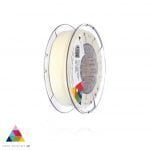
Para uma correcta manutenção da sua impressora 3D, recomendamos sempre que trocar de material de filamento 3D, a efectuar uma purga com filamento especial de limpeza.
Desta forma garante que não ficam vestígios de material nas paredes do nozzle, evitando o acumular de crosta que é criado sempre que efectua trocas de material.
Com este produto evita problema como "clogs" e "jams" e fará com que o seu nozzle mantenha-se sempre limpo, durando muito mais tempo.
Poderá encontrar a partir de 1.49€ no seguinte LINK
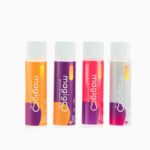
Este material é considerado de difícil aderência à superfície da plataforma de impressão 3D de vidro ou PEI. Para evitar problemas de warpping e de aderência das peças, recomendamos a aplicar potenciador de aderência especial para PA Nylon.
Poderá encontrar no seguinte LINK
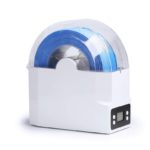
Normalmente os filamentos Nylon são altamente higroscópicos, absorvendo rapidamente a humidade do ar passados poucos minutos após abertos, impossibilitando desta forma a correcta impressão 3D do mesmos. O resultado das impressões 3D de materiais com humidade tendem a ser frágeis e de acabamento irregular ou em certos casos, torna-se simplesmente impossíveis de imprimir.
Deverá de usar soluções de caixas fechadas com dessecante como sílica ou caixas próprias secadoras de filamento. AVISO: O recurso a forno para secagem do filamento invalida a garantia.
Poderá encontrar no seguinte LINK
Documentos para Download:
Technical Data Sheet
Safety Data Sheet
Rohs
10m (Amostra) - Rolo
Nylon PAJet 160 Natur - Cor
1.75mm (+-0.05mm) - Espessura
230º a 240º - Temp. recomendada do Hotend
40º a 120º - Temp. recomendada da Heated bed (mediante aplicação de Magigoo PA)
Difícil - Facilidade de Impressão
PPJet (polipropileno)
- plástico técnico de uso comum
- elevada resistência química a ácidos, alcalinos, óleos, sais, água, etc.
- um dos plásticos mais utilizados em várias indústrias, adequado para prototipagem e testes de propriedade
- baixa densidade - para que a luz possa flutuar sobre a água
- material altamente resistente e flexível, tem uma adesão de camadas elevadas, portanto é extremamente resistente ao impacto
- resistência ao calor (até 100 °C)
- inofensivo à saúde
O filamento PP cria a possibilidade de impressão 3D com o segundo polímero mais utilizado no mundo - Polipropileno.
Devido à sua elevada resistência aos danos e à notável flexibilidade, bem como à resistência a substâncias químicas (ácidos, bases, água), encontrou muitas aplicações em vários domínios da indústria e no uso quotidiano.
O PP pode ser impressa com quase qualquer impressora 3D sem a necessidade de uma câmara fechada.
O polipropileno (PP) é um dos polímeros mais utilizados na indústria. A sua elevada flexibilidade, durabilidade incrível, baixo peso e resistência aos produtos químicos fizeram com que encontrasse inúmeras aplicações da medicina, passando pela indústria automóvel para a indústria de embalagens. O filamento PP aproveitou o potencial deste material incrível e tornou possível a utilização na impressão 3D.
A impressionante resistência à tração torna o polipropileno perfeito para produzir elementos que requerem durabilidade, mantendo a flexibilidade, tais como recipientes bloqueáveis, pegas, etc.
É utilizado com sucesso em projetos de engenharia avançada e em casa.
O polipropileno é reciclável, razão pela qual as impressões e a sucata da impressora podem ser segregadas com outros lixos e reciclados, o que reflete perfeitamente o espírito da ideia de "desperdício zero".
APLICAÇÃO EM IMPRESSÃO 3D:
ARTIGOS DE USO DIÁRIO: caixas com fecho, cabides, pegas, fixadores, correias de relógio
MOTORIZAÇÃO: para-choques, para-choques, capas
BRINQUEDOS: estatuetas, carros e suas partes, drones
ARTIGOS DE COZINHA: recipientes de alimentos, pratos
MEDICINA: tubos de ensaio, vasos laboratoriais
Propriedades:
não tóxico e inodoro
alta resistência aos produtos químicos
resistência a danos mecânicos
adesão muito boa entre as camadas de impressão
adequado para o contacto com os alimentos

Para uma correcta manutenção da sua impressora 3D, recomendamos sempre que trocar de material de filamento 3D, a efectuar uma purga com filamento especial de limpeza.
Desta forma garante que não ficam vestígios de material nas paredes do nozzle, evitando o acumular de crosta que é criado sempre que efectua trocas de material.
Com este produto evita problema como "clogs" e "jams" e fará com que o seu nozzle mantenha-se sempre limpo, durando muito mais tempo.
Poderá encontrar a partir de 1.49€ no seguinte LINK

Este material é considerado de difícil aderência à superfície da plataforma de impressão 3D de vidro ou PEI. Para evitar problemas de warpping e de aderência das peças, recomendamos a aplicar potenciador de aderência especial para PP.
Poderá encontrar no seguinte LINK

Este material é altamente higroscópico, absorvendo rapidamente a humidade do ar passados poucos minutos após aberto, impossibilitando desta forma a correcta impressão 3D do mesmo. O resultado das impressões 3D de materiais com humidade tendem a ser frágeis e de acabamento irregular ou em certos casos, torna-se simplesmente impossíveis de imprimir.
Deverá de usar soluções de caixas fechadas com dessecante como sílica ou caixas próprias secadoras de filamento.
Poderá encontrar no seguinte LINK
PRINTING SETUP
Nozzle: 210 - 230 °C
Heatbed: 80 - 100 °C
▪ draft-free environment, closed chamber recommended
▪ fan speed: 100%
▪ for a better adhesion using the MAGIGOO PP glue or printing on an office PP tape is recommended
▪ for the bigger object we recommend using function brim - 5 mm
▪ it's also necessary to lower pressure under the extruder wheel
Documentos para Download:
Technical Data Sheet
Safety Data Sheet
Rohs
10m (Amostra) - Rolo
PPJet (polypropylene) Natur - Cor
1.75mm (+-0.05mm) - Espessura
210º a 230º - Temp. recomendada do Hotend
80º a 100º - Temp. recomendada da Heated bed (mediante aplicação de Magigoo PP)
Difícil - Facilidade de Impressão
Ver esta publicação no Instagram
Ver esta publicação no Instagram
PC/ABS (policarbonato + akrylonitrilbutadienstyren)
- mistura única de policarbonato e ABS
- material extremamente resistente e resistente ao calor, altamente resistente ao impacto e à resistência ao calor (até 115 °C)
- autoextinção e retardador de chama (certificação UL94 V0)
ideal para uso industrial
- componentes mecânicos
O filamento de policarbonato (PC) é um dos plásticos mais resistentes do mercado, estando apto para ser utilizado em altas temperturas, sem deformar e resistente a impactos. É considerado um bom isolante elétrico e possui resistência a solventes, gorduras e óleos.
PC é o material perfeito para impressões 3D mais fortes e duráveis.
Os policarbonatos são um grupo de plásticos conhecidos pela sua força, durabilidade mecânica, dureza e resistência à temperatura. São frequentemente utilizados para a produção de CDs, óculos de protecção ou faróis de carro.
A composição do policarbonato puro é um material não adequado para a impressão 3D. Adere muito mal à plataforma de impressão e devido à sua alta expansão térmica, tem tendência a deformar-se e a rachar( layer cracking). Neste filamento, a Prusament adicionou aditivos cuidadosamente seleccionados, melhorando a adesão e reduzindo o fenómeno de layer cracking e a deformação, mantendo ao mesmo tempo as excelentes propriedades do policarbonato.
PC é adequado para utilizadores avançados. Se você é novo em impressão 3D, recomendamos que fique com materiais mais fáceis de imprimir, tais como PLA e PETG .
PC é recomendado para proprietários experientes de impressoras 3D que procuram material duro e durável para a produção de protótipos e peças funcionais, componentes térmicos e sujeitos a stress mecânico.
Filamento ABS para impressão 3D da marca Filament PM, de qualidade premium, com enrolamento perfeito, indicado tanto para utilizadores mais avançados e profissionais como para quem está a começar.
Este é um filamento fabricado na Europa segundo as mais rigorosas normas de qualidade.
A marca Filament PM ficou conhecida por fabricar e fornecer os filamentos para a conceituada marca de impressoras Original Prusa i3 by Josef Prusa.

Para uma correcta manutenção da sua impressora 3D, recomendamos sempre que trocar de material de filamento 3D, a efectuar uma purga com filamento especial de limpeza.
Desta forma garante que não ficam vestígios de material nas paredes do nozzle, evitando o acumular de crosta que é criado sempre que efectua trocas de material.
Com este produto evita problema como "clogs" e "jams" e fará com que o seu nozzle mantenha-se sempre limpo, durando muito mais tempo.
Poderá encontrar a partir de 1.49€ no seguinte LINK

Este material é considerado de difícil aderência à superfície da plataforma de impressão 3D de vidro ou PEI. Para evitar problemas de warpping e de aderência das peças, recomendamos a aplicar potenciador de aderência especial para PC Policarbonato.
Poderá encontrar no seguinte LINK

Este material é altamente higroscópico, absorvendo rapidamente a humidade do ar passados poucos minutos após aberto, impossibilitando desta forma a correcta impressão 3D do mesmo. O resultado das impressões 3D de materiais com humidade tendem a ser frágeis e de acabamento irregular ou em certos casos, torna-se simplesmente impossíveis de imprimir.
Deverá de usar soluções de caixas fechadas com dessecante como sílica ou caixas próprias secadoras de filamento.
Poderá encontrar no seguinte LINK
Documentos para Download:
UL94 V0
Technical Data Sheet
Safety Data Sheet
Rohs
10m (Amostra) - Rolo
PC/ABS Grey - Cor
1.75mm (+-0.05mm) - Espessura
240º a 260º - Temp. recomendada do Hotend
100º a 110º - Temp. recomendada da Heated bed (mediante aplicação de Magigoo PC)
Difícil - Facilidade de Impressão

ProtoPasta é uma empresa situada nos Estados Unidos da América, de produção de filamentos para impressão 3D de alta qualidade.
Caracterizada pelos rolos feitos em cartão, esta marca é mundialmente famosa por ser especializada em materiais como PLA e ABS modificados com outros materiais, como o PLA Magnético; o PLA Condutivo; PLA de fibra de carbono; HTPLA de cobre, latão ou bronze; ou o ABS-PC.
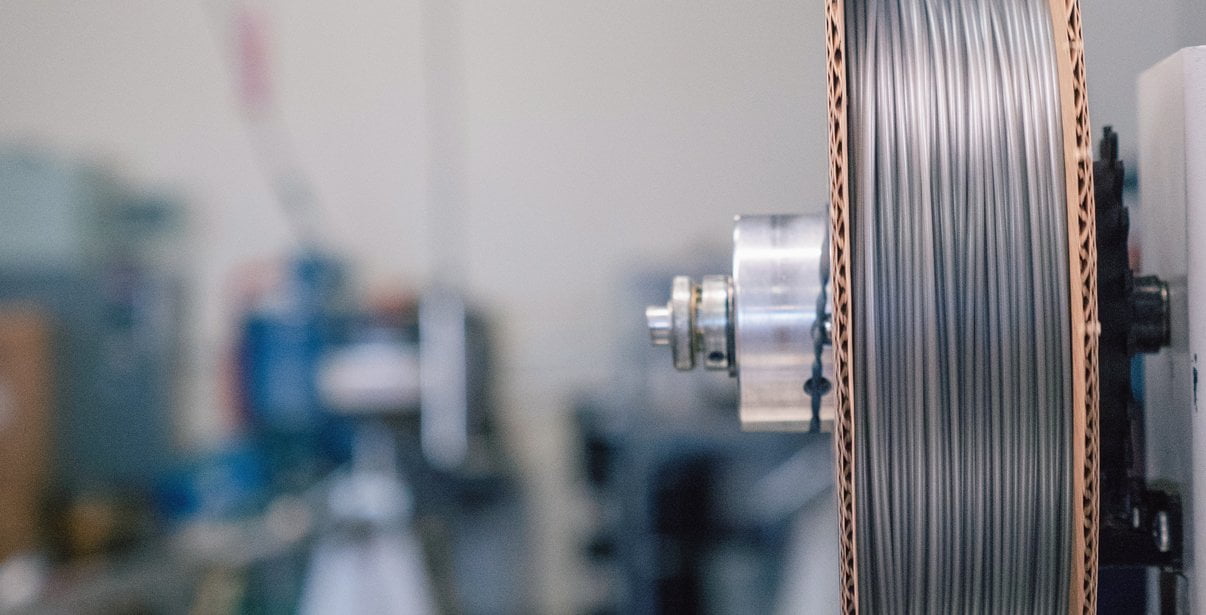
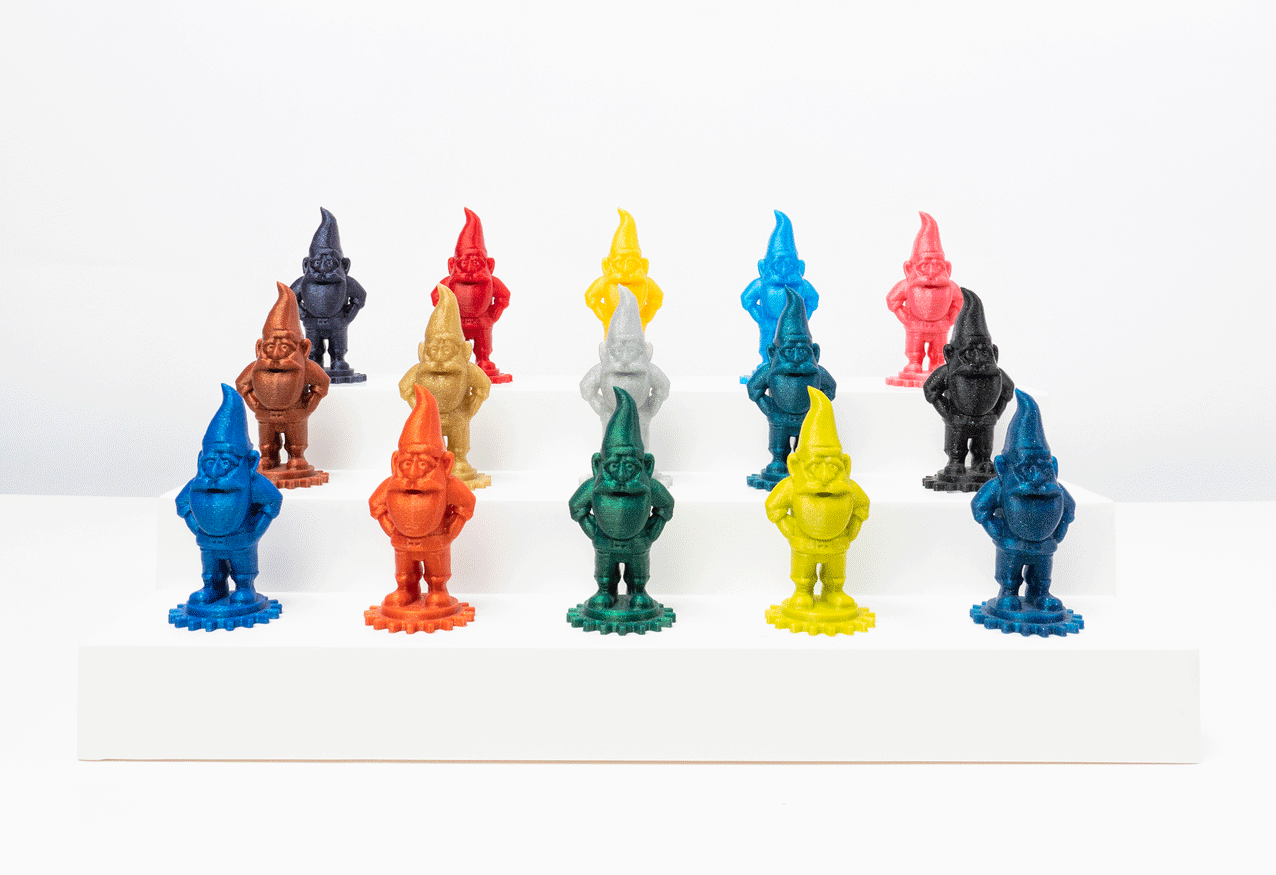
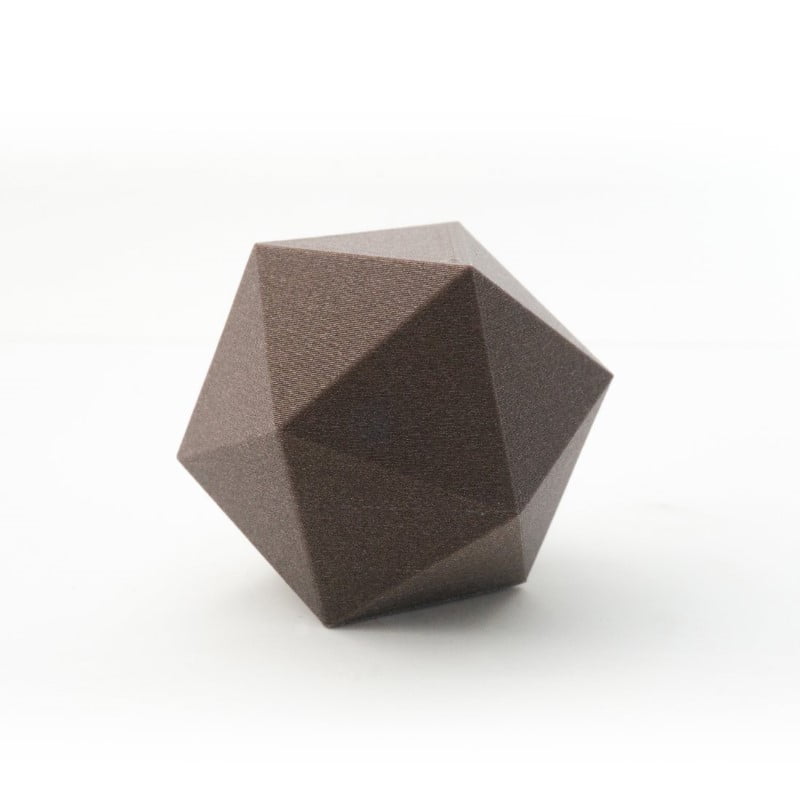
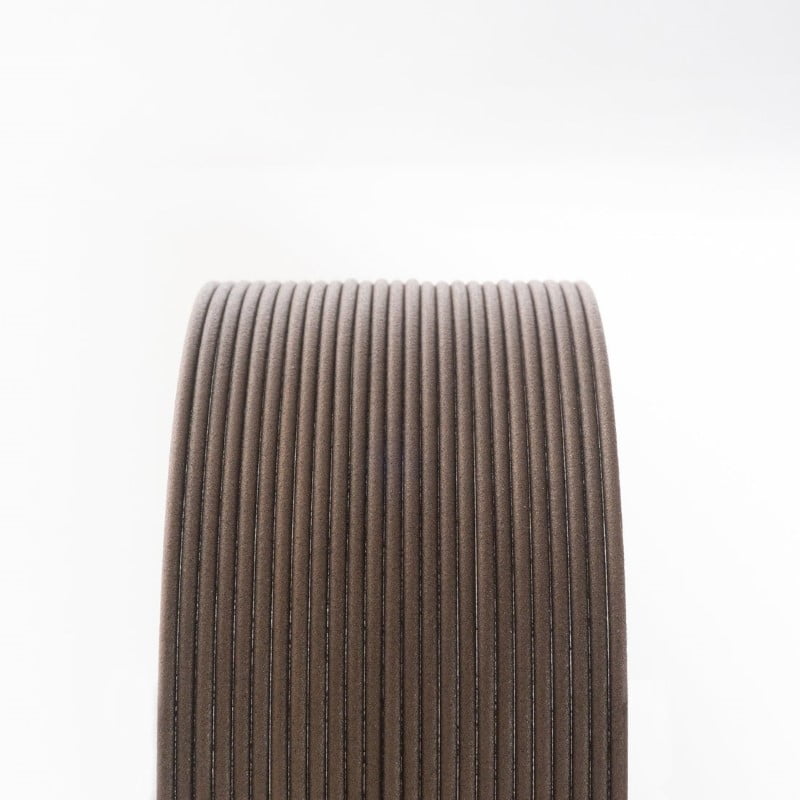
An extension of our Matte Fiber line, these rich colors are enhanced with small black flecks to create a wood-like appearance. Ranging from a beautiful soft yellow to deep, dark walnut, we’ve covered the spectrum and are excited to share their beauty with all of you!



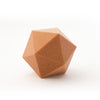


L to R: Walnut, Chestnut, Mahogany, Honey, Daffodil, Olive
These materials are based in Matte Fiber, but with fine gold pearl and black flecks, bringing warmth, radiance, and texture with just the right tones and sheen you’d expect for a premium wood-like finish.

All example parts were printed as follows for a balance of quality, speed, and reliability:
Machine(s): Prusa MK2/3, Creality Ender 3
Nozzle: 0.4 mm standard brass w/ sock
Nozzle Temp: 205C Bed Temp: 60C Bed Type: Glass, PEI, BuildTak, or other
Bed Prep: Clean w/ water or alcohol; Magigoo for additional adhesion + easy release when cool
Outlines: 3 Top/Bot layers: 6 Infill type: Lines Infill: 25%
Overlaps: 0 Min layer time: 0 Min Speed: 0 Fill gaps: no Expansion: 0
| Layer height | Ext width | Speed | Fan | |
| 1st Layer | 0.20mm | 0.50mm | 20mm/s | 0% |
| Rest of print | 0.15mm | 0.45mm | 30mm/s | 100% |
Matte Fiber can create beautiful, rigid parts that don’t even look 3D printed. Like wood, Matte Fiber does not bend much before breaking.
Please don’t use excessive force when loading and printing.
Matte Fiber also absorbs moisture like wood, and should be printed at the lowest possible temperature to minimize stringing, over-extrusion, and jamming.
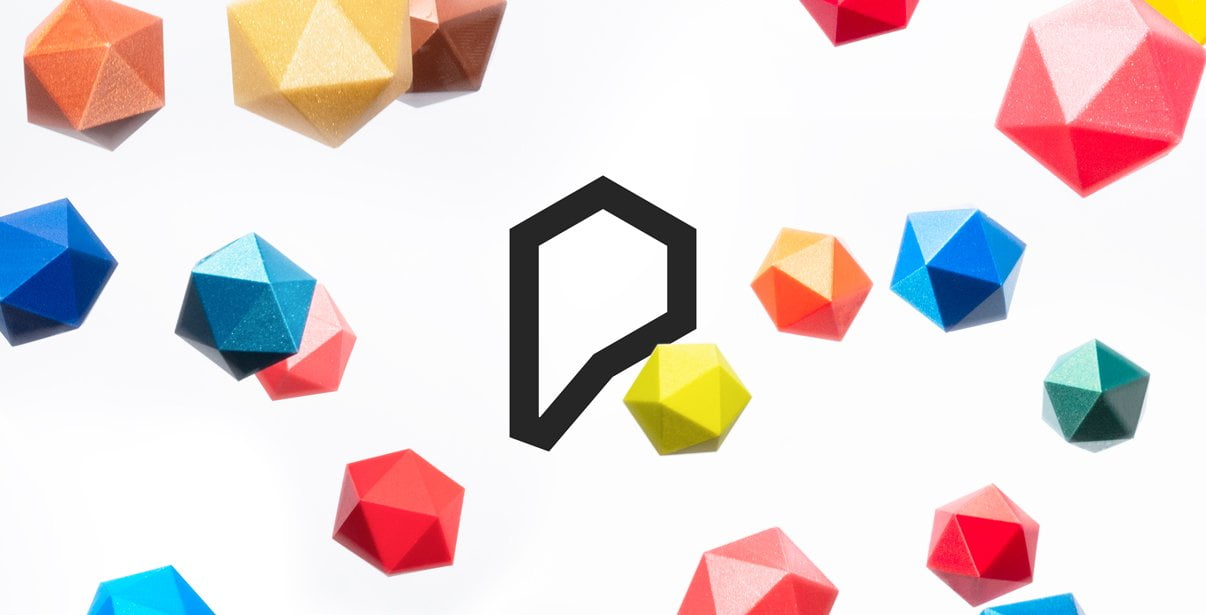
We've created this page to bring you a premium PLA and HTPLA printing experience that rivals our premium material. Follow below to improve your 3D printing experience. In other words, here's your shortcut to awesomeness with pasta. If at the end of this document you have questions or need assistance, please contact us at [email protected].
Loose coils can be very tricky to manage. Going cowboy on your spool handling can quickly end up in a frustrating, tangled mess. Keep your loose coils wrangled with a spool holder like masterspool for a more trouble-free experience. Find out more about loose coil handling in Keith's blog post.
And for spooled filament, never let go of the loose end. When not in the printer extruder, tuck it away in the cardboard spool's corrugation! Also, avoid sharp bends and excessive force when loading filament into your printer.
At Proto-pasta, we make high quality filament. We aspire to make exceptional results easy, but a positive result is very much dependent on your hardware, set-up, adjustments, and process parameters. Matching hardware with process and material for a positive experience is not always straight-forward, but you can start by pairing the following settings with your printer for a good starting point, then tune or troubleshoot as required.
Volume flow rate together with temperature dictates how melted the material is. This is hardware & condition dependent based on hot end, nozzle & extruder type, material & manufacturer as well as layer fan type, position & settings. Extrusion width, layer thickness & speed changes affect volume flow which may change required/desired temperature.
Post your prints & tag us @Proto_pasta on Twitter and Instagram. Need more help? Consider typical pitfalls and fixes below.
We visited Joel and ended up with a helpful video on the subject:

Para uma correcta manutenção da sua impressora 3D, recomendamos sempre que trocar de material de filamento 3D, a efectuar uma purga com filamento especial de limpeza.
Desta forma garante que não ficam vestígios de material nas paredes do nozzle, evitando o acumular de crosta que é criado sempre que efectua trocas de material.
Com este produto evita problema como "clogs" e "jams" e fará com que o seu nozzle mantenha-se sempre limpo, durando muito mais tempo.
Poderá encontrar a partir de 1.49€ no seguinte LINK
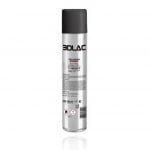
Para obter maior aderência à superfície da sua impressora 3D recomendamos a aplicar 3DLAC na base da plataforma.
Poderá encontrar no seguinte LINK

Este material é altamente higroscópico, absorvendo rapidamente a humidade do ar passados poucos minutos após aberto, impossibilitando desta forma a correcta impressão 3D do mesmo. O resultado das impressões 3D de materiais com humidade tendem a ser frágeis e de acabamento irregular ou em certos casos, torna-se simplesmente impossíveis de imprimir.
Deverá de usar soluções de caixas fechadas com dessecante como sílica ou caixas próprias secadoras de filamento.
Poderá encontrar no seguinte LINK
Download:
Technical and Safety Data Sheet
50g- Rolo
HTPLA Walnut Wood ( Matte Fiber ) - Cor
1.75mm (+-0.05mm) - Espessura / Tolerância de diâmetro
Muito Fácil - Facilidade de Impressão

ProtoPasta é uma empresa situada nos Estados Unidos da América, de produção de filamentos para impressão 3D de alta qualidade.
Caracterizada pelos rolos feitos em cartão, esta marca é mundialmente famosa por ser especializada em materiais como PLA e ABS modificados com outros materiais, como o PLA Magnético; o PLA Condutivo; PLA de fibra de carbono; HTPLA de cobre, latão ou bronze; ou o ABS-PC.


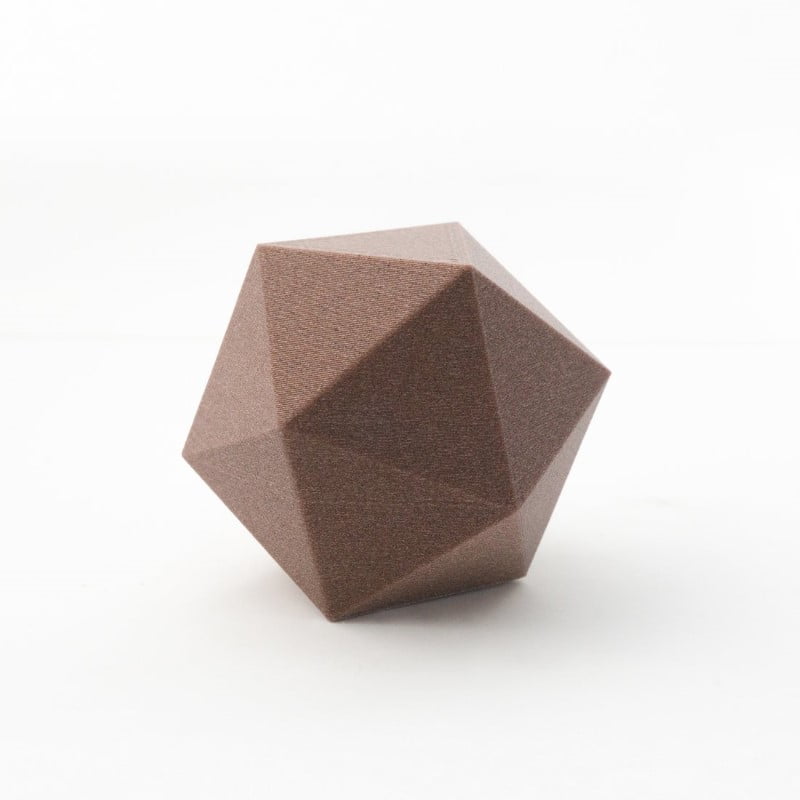
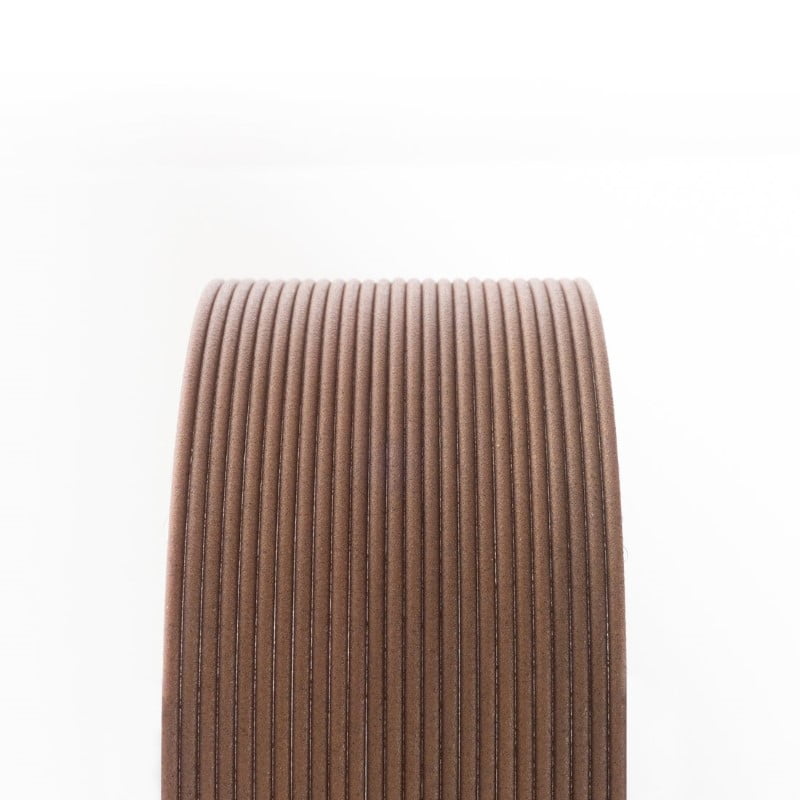
An extension of our Matte Fiber line, these rich colors are enhanced with small black flecks to create a wood-like appearance. Ranging from a beautiful soft yellow to deep, dark walnut, we’ve covered the spectrum and are excited to share their beauty with all of you!






L to R: Walnut, Chestnut, Mahogany, Honey, Daffodil, Olive
These materials are based in Matte Fiber, but with fine gold pearl and black flecks, bringing warmth, radiance, and texture with just the right tones and sheen you’d expect for a premium wood-like finish.

All example parts were printed as follows for a balance of quality, speed, and reliability:
Machine(s): Prusa MK2/3, Creality Ender 3
Nozzle: 0.4 mm standard brass w/ sock
Nozzle Temp: 205C Bed Temp: 60C Bed Type: Glass, PEI, BuildTak, or other
Bed Prep: Clean w/ water or alcohol; Magigoo for additional adhesion + easy release when cool
Outlines: 3 Top/Bot layers: 6 Infill type: Lines Infill: 25%
Overlaps: 0 Min layer time: 0 Min Speed: 0 Fill gaps: no Expansion: 0
| Layer height | Ext width | Speed | Fan | |
| 1st Layer | 0.20mm | 0.50mm | 20mm/s | 0% |
| Rest of print | 0.15mm | 0.45mm | 30mm/s | 100% |
Matte Fiber can create beautiful, rigid parts that don’t even look 3D printed. Like wood, Matte Fiber does not bend much before breaking.
Please don’t use excessive force when loading and printing.
Matte Fiber also absorbs moisture like wood, and should be printed at the lowest possible temperature to minimize stringing, over-extrusion, and jamming.

We've created this page to bring you a premium PLA and HTPLA printing experience that rivals our premium material. Follow below to improve your 3D printing experience. In other words, here's your shortcut to awesomeness with pasta. If at the end of this document you have questions or need assistance, please contact us at [email protected].
Loose coils can be very tricky to manage. Going cowboy on your spool handling can quickly end up in a frustrating, tangled mess. Keep your loose coils wrangled with a spool holder like masterspool for a more trouble-free experience. Find out more about loose coil handling in Keith's blog post.
And for spooled filament, never let go of the loose end. When not in the printer extruder, tuck it away in the cardboard spool's corrugation! Also, avoid sharp bends and excessive force when loading filament into your printer.
At Proto-pasta, we make high quality filament. We aspire to make exceptional results easy, but a positive result is very much dependent on your hardware, set-up, adjustments, and process parameters. Matching hardware with process and material for a positive experience is not always straight-forward, but you can start by pairing the following settings with your printer for a good starting point, then tune or troubleshoot as required.
Volume flow rate together with temperature dictates how melted the material is. This is hardware & condition dependent based on hot end, nozzle & extruder type, material & manufacturer as well as layer fan type, position & settings. Extrusion width, layer thickness & speed changes affect volume flow which may change required/desired temperature.
Post your prints & tag us @Proto_pasta on Twitter and Instagram. Need more help? Consider typical pitfalls and fixes below.
We visited Joel and ended up with a helpful video on the subject:

Para uma correcta manutenção da sua impressora 3D, recomendamos sempre que trocar de material de filamento 3D, a efectuar uma purga com filamento especial de limpeza.
Desta forma garante que não ficam vestígios de material nas paredes do nozzle, evitando o acumular de crosta que é criado sempre que efectua trocas de material.
Com este produto evita problema como "clogs" e "jams" e fará com que o seu nozzle mantenha-se sempre limpo, durando muito mais tempo.
Poderá encontrar a partir de 1.49€ no seguinte LINK

Para obter maior aderência à superfície da sua impressora 3D recomendamos a aplicar 3DLAC na base da plataforma.
Poderá encontrar no seguinte LINK

Este material é altamente higroscópico, absorvendo rapidamente a humidade do ar passados poucos minutos após aberto, impossibilitando desta forma a correcta impressão 3D do mesmo. O resultado das impressões 3D de materiais com humidade tendem a ser frágeis e de acabamento irregular ou em certos casos, torna-se simplesmente impossíveis de imprimir.
Deverá de usar soluções de caixas fechadas com dessecante como sílica ou caixas próprias secadoras de filamento.
Poderá encontrar no seguinte LINK
Download:
Technical and Safety Data Sheet
50g- Rolo
HTPLA Chestnut Wood ( Matte Fiber ) - Cor
1.75mm (+-0.05mm) - Espessura / Tolerância de diâmetro
Muito Fácil - Facilidade de Impressão

ProtoPasta é uma empresa situada nos Estados Unidos da América, de produção de filamentos para impressão 3D de alta qualidade.
Caracterizada pelos rolos feitos em cartão, esta marca é mundialmente famosa por ser especializada em materiais como PLA e ABS modificados com outros materiais, como o PLA Magnético; o PLA Condutivo; PLA de fibra de carbono; HTPLA de cobre, latão ou bronze; ou o ABS-PC.


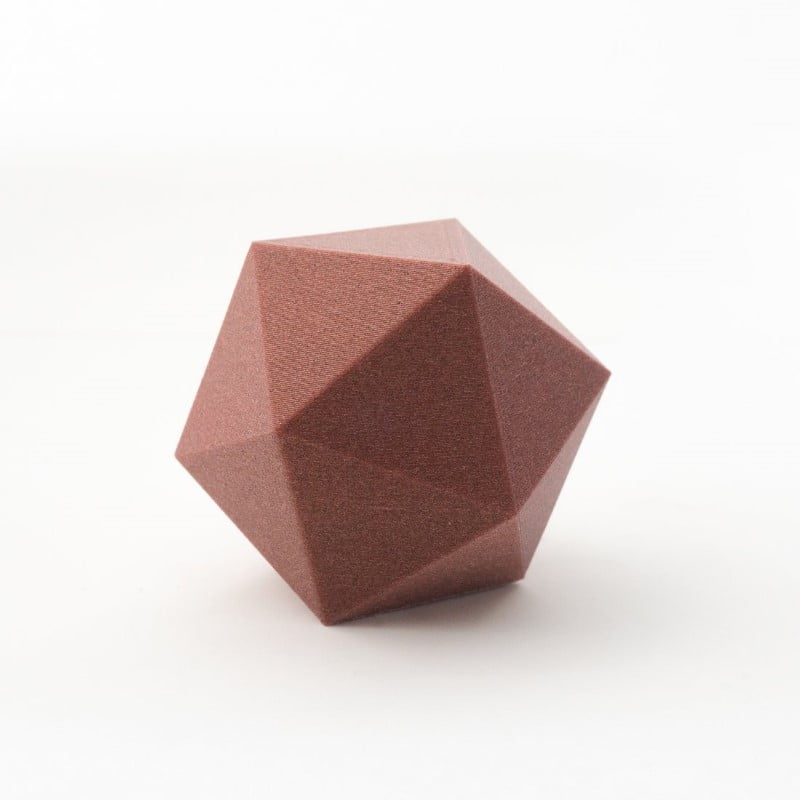
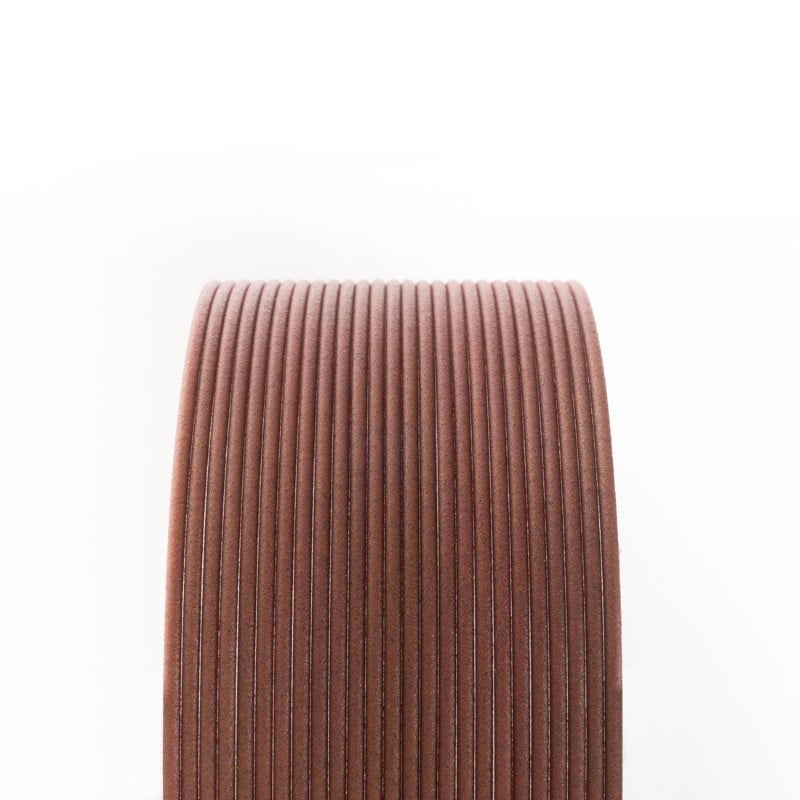
An extension of our Matte Fiber line, these rich colors are enhanced with small black flecks to create a wood-like appearance. Ranging from a beautiful soft yellow to deep, dark walnut, we’ve covered the spectrum and are excited to share their beauty with all of you!






L to R: Walnut, Chestnut, Mahogany, Honey, Daffodil, Olive
These materials are based in Matte Fiber, but with fine gold pearl and black flecks, bringing warmth, radiance, and texture with just the right tones and sheen you’d expect for a premium wood-like finish.

All example parts were printed as follows for a balance of quality, speed, and reliability:
Machine(s): Prusa MK2/3, Creality Ender 3
Nozzle: 0.4 mm standard brass w/ sock
Nozzle Temp: 205C Bed Temp: 60C Bed Type: Glass, PEI, BuildTak, or other
Bed Prep: Clean w/ water or alcohol; Magigoo for additional adhesion + easy release when cool
Outlines: 3 Top/Bot layers: 6 Infill type: Lines Infill: 25%
Overlaps: 0 Min layer time: 0 Min Speed: 0 Fill gaps: no Expansion: 0
| Layer height | Ext width | Speed | Fan | |
| 1st Layer | 0.20mm | 0.50mm | 20mm/s | 0% |
| Rest of print | 0.15mm | 0.45mm | 30mm/s | 100% |
Matte Fiber can create beautiful, rigid parts that don’t even look 3D printed. Like wood, Matte Fiber does not bend much before breaking.
Please don’t use excessive force when loading and printing.
Matte Fiber also absorbs moisture like wood, and should be printed at the lowest possible temperature to minimize stringing, over-extrusion, and jamming.

We've created this page to bring you a premium PLA and HTPLA printing experience that rivals our premium material. Follow below to improve your 3D printing experience. In other words, here's your shortcut to awesomeness with pasta. If at the end of this document you have questions or need assistance, please contact us at [email protected].
Loose coils can be very tricky to manage. Going cowboy on your spool handling can quickly end up in a frustrating, tangled mess. Keep your loose coils wrangled with a spool holder like masterspool for a more trouble-free experience. Find out more about loose coil handling in Keith's blog post.
And for spooled filament, never let go of the loose end. When not in the printer extruder, tuck it away in the cardboard spool's corrugation! Also, avoid sharp bends and excessive force when loading filament into your printer.
At Proto-pasta, we make high quality filament. We aspire to make exceptional results easy, but a positive result is very much dependent on your hardware, set-up, adjustments, and process parameters. Matching hardware with process and material for a positive experience is not always straight-forward, but you can start by pairing the following settings with your printer for a good starting point, then tune or troubleshoot as required.
Volume flow rate together with temperature dictates how melted the material is. This is hardware & condition dependent based on hot end, nozzle & extruder type, material & manufacturer as well as layer fan type, position & settings. Extrusion width, layer thickness & speed changes affect volume flow which may change required/desired temperature.
Post your prints & tag us @Proto_pasta on Twitter and Instagram. Need more help? Consider typical pitfalls and fixes below.
We visited Joel and ended up with a helpful video on the subject:

Para uma correcta manutenção da sua impressora 3D, recomendamos sempre que trocar de material de filamento 3D, a efectuar uma purga com filamento especial de limpeza.
Desta forma garante que não ficam vestígios de material nas paredes do nozzle, evitando o acumular de crosta que é criado sempre que efectua trocas de material.
Com este produto evita problema como "clogs" e "jams" e fará com que o seu nozzle mantenha-se sempre limpo, durando muito mais tempo.
Poderá encontrar a partir de 1.49€ no seguinte LINK

Para obter maior aderência à superfície da sua impressora 3D recomendamos a aplicar 3DLAC na base da plataforma.
Poderá encontrar no seguinte LINK

Este material é altamente higroscópico, absorvendo rapidamente a humidade do ar passados poucos minutos após aberto, impossibilitando desta forma a correcta impressão 3D do mesmo. O resultado das impressões 3D de materiais com humidade tendem a ser frágeis e de acabamento irregular ou em certos casos, torna-se simplesmente impossíveis de imprimir.
Deverá de usar soluções de caixas fechadas com dessecante como sílica ou caixas próprias secadoras de filamento.
Poderá encontrar no seguinte LINK
Download:
Technical and Safety Data Sheet
50g- Rolo
HTPLA Mahogany Wood ( Matte Fiber ) - Cor
1.75mm (+-0.05mm) - Espessura / Tolerância de diâmetro
Muito Fácil - Facilidade de Impressão

ProtoPasta é uma empresa situada nos Estados Unidos da América, de produção de filamentos para impressão 3D de alta qualidade.
Caracterizada pelos rolos feitos em cartão, esta marca é mundialmente famosa por ser especializada em materiais como PLA e ABS modificados com outros materiais, como o PLA Magnético; o PLA Condutivo; PLA de fibra de carbono; HTPLA de cobre, latão ou bronze; ou o ABS-PC.


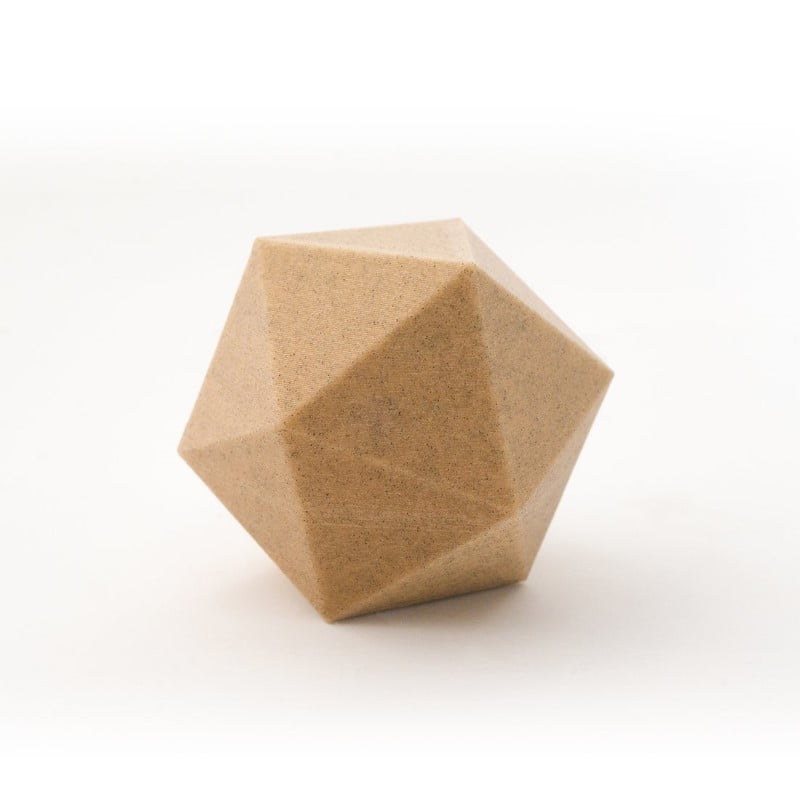
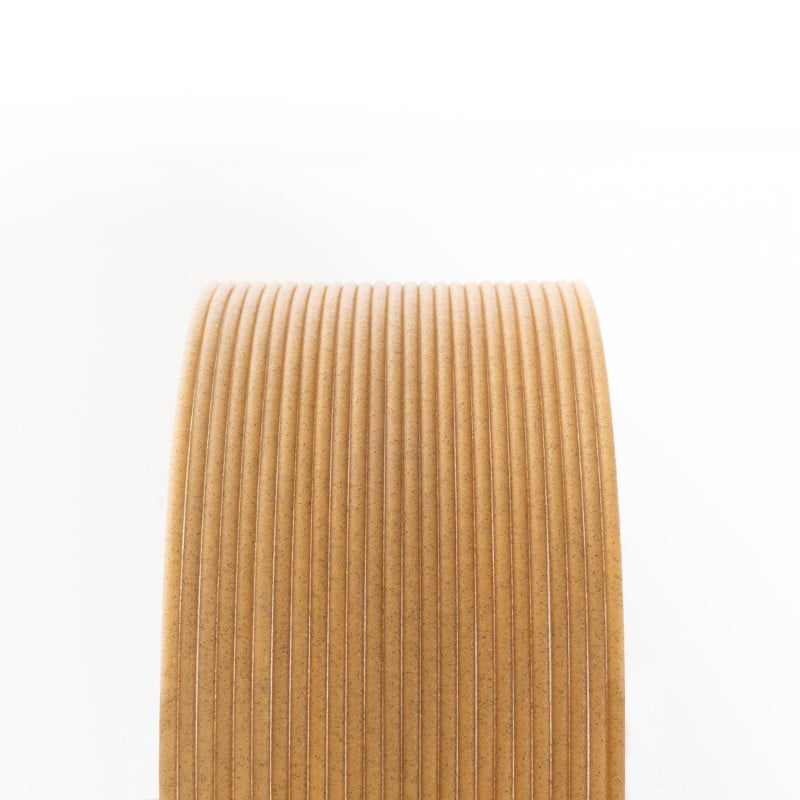
An extension of our Matte Fiber line, these rich colors are enhanced with small black flecks to create a wood-like appearance. Ranging from a beautiful soft yellow to deep, dark walnut, we’ve covered the spectrum and are excited to share their beauty with all of you!






L to R: Walnut, Chestnut, Mahogany, Honey, Daffodil, Olive
These materials are based in Matte Fiber, but with fine gold pearl and black flecks, bringing warmth, radiance, and texture with just the right tones and sheen you’d expect for a premium wood-like finish.

All example parts were printed as follows for a balance of quality, speed, and reliability:
Machine(s): Prusa MK2/3, Creality Ender 3
Nozzle: 0.4 mm standard brass w/ sock
Nozzle Temp: 205C Bed Temp: 60C Bed Type: Glass, PEI, BuildTak, or other
Bed Prep: Clean w/ water or alcohol; Magigoo for additional adhesion + easy release when cool
Outlines: 3 Top/Bot layers: 6 Infill type: Lines Infill: 25%
Overlaps: 0 Min layer time: 0 Min Speed: 0 Fill gaps: no Expansion: 0
| Layer height | Ext width | Speed | Fan | |
| 1st Layer | 0.20mm | 0.50mm | 20mm/s | 0% |
| Rest of print | 0.15mm | 0.45mm | 30mm/s | 100% |
Matte Fiber can create beautiful, rigid parts that don’t even look 3D printed. Like wood, Matte Fiber does not bend much before breaking.
Please don’t use excessive force when loading and printing.
Matte Fiber also absorbs moisture like wood, and should be printed at the lowest possible temperature to minimize stringing, over-extrusion, and jamming.

We've created this page to bring you a premium PLA and HTPLA printing experience that rivals our premium material. Follow below to improve your 3D printing experience. In other words, here's your shortcut to awesomeness with pasta. If at the end of this document you have questions or need assistance, please contact us at [email protected].
Loose coils can be very tricky to manage. Going cowboy on your spool handling can quickly end up in a frustrating, tangled mess. Keep your loose coils wrangled with a spool holder like masterspool for a more trouble-free experience. Find out more about loose coil handling in Keith's blog post.
And for spooled filament, never let go of the loose end. When not in the printer extruder, tuck it away in the cardboard spool's corrugation! Also, avoid sharp bends and excessive force when loading filament into your printer.
At Proto-pasta, we make high quality filament. We aspire to make exceptional results easy, but a positive result is very much dependent on your hardware, set-up, adjustments, and process parameters. Matching hardware with process and material for a positive experience is not always straight-forward, but you can start by pairing the following settings with your printer for a good starting point, then tune or troubleshoot as required.
Volume flow rate together with temperature dictates how melted the material is. This is hardware & condition dependent based on hot end, nozzle & extruder type, material & manufacturer as well as layer fan type, position & settings. Extrusion width, layer thickness & speed changes affect volume flow which may change required/desired temperature.
Post your prints & tag us @Proto_pasta on Twitter and Instagram. Need more help? Consider typical pitfalls and fixes below.
We visited Joel and ended up with a helpful video on the subject:

Para uma correcta manutenção da sua impressora 3D, recomendamos sempre que trocar de material de filamento 3D, a efectuar uma purga com filamento especial de limpeza.
Desta forma garante que não ficam vestígios de material nas paredes do nozzle, evitando o acumular de crosta que é criado sempre que efectua trocas de material.
Com este produto evita problema como "clogs" e "jams" e fará com que o seu nozzle mantenha-se sempre limpo, durando muito mais tempo.
Poderá encontrar a partir de 1.49€ no seguinte LINK

Para obter maior aderência à superfície da sua impressora 3D recomendamos a aplicar 3DLAC na base da plataforma.
Poderá encontrar no seguinte LINK

Este material é altamente higroscópico, absorvendo rapidamente a humidade do ar passados poucos minutos após aberto, impossibilitando desta forma a correcta impressão 3D do mesmo. O resultado das impressões 3D de materiais com humidade tendem a ser frágeis e de acabamento irregular ou em certos casos, torna-se simplesmente impossíveis de imprimir.
Deverá de usar soluções de caixas fechadas com dessecante como sílica ou caixas próprias secadoras de filamento.
Poderá encontrar no seguinte LINK
Download:
Technical and Safety Data Sheet
50g- Rolo
HTPLA Daffodil Wood ( Matte Fiber ) - Cor
1.75mm (+-0.05mm) - Espessura / Tolerância de diâmetro
Muito Fácil - Facilidade de Impressão

ProtoPasta é uma empresa situada nos Estados Unidos da América, de produção de filamentos para impressão 3D de alta qualidade.
Caracterizada pelos rolos feitos em cartão, esta marca é mundialmente famosa por ser especializada em materiais como PLA e ABS modificados com outros materiais, como o PLA Magnético; o PLA Condutivo; PLA de fibra de carbono; HTPLA de cobre, latão ou bronze; ou o ABS-PC.


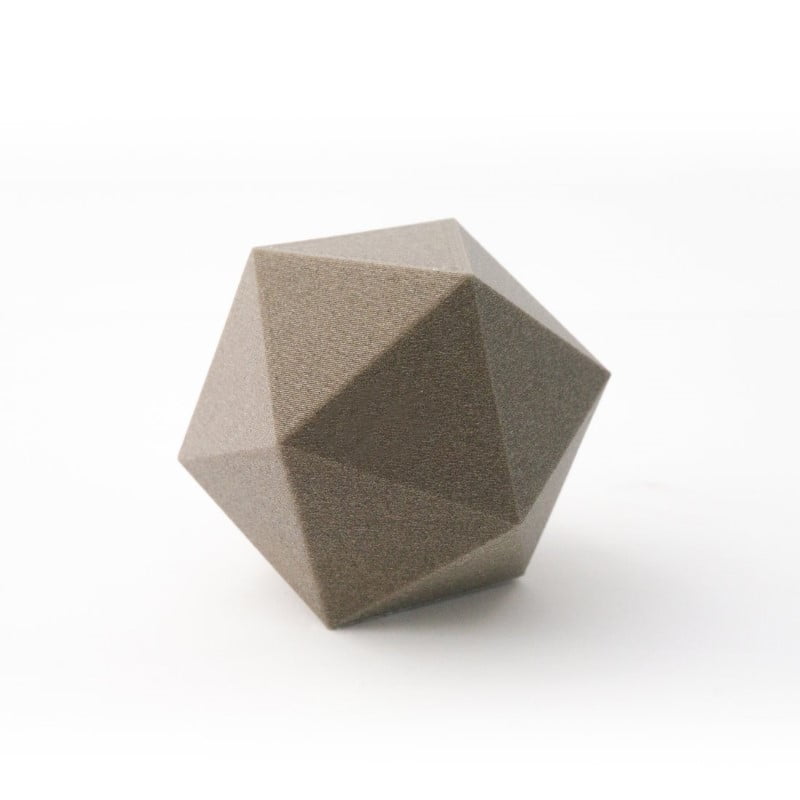
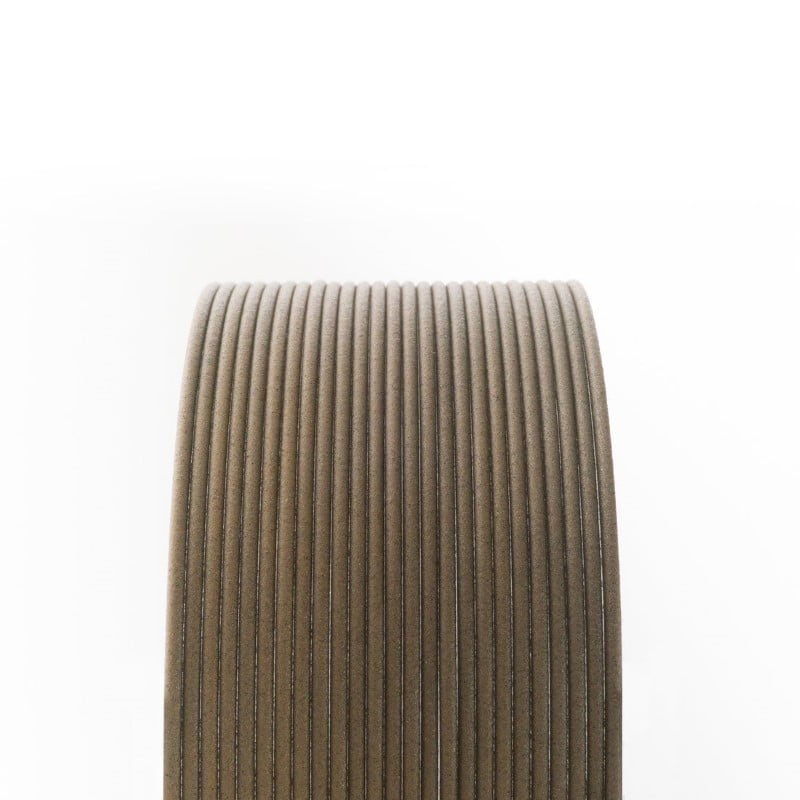
An extension of our Matte Fiber line, these rich colors are enhanced with small black flecks to create a wood-like appearance. Ranging from a beautiful soft yellow to deep, dark walnut, we’ve covered the spectrum and are excited to share their beauty with all of you!






L to R: Walnut, Chestnut, Mahogany, Honey, Daffodil, Olive
These materials are based in Matte Fiber, but with fine gold pearl and black flecks, bringing warmth, radiance, and texture with just the right tones and sheen you’d expect for a premium wood-like finish.

All example parts were printed as follows for a balance of quality, speed, and reliability:
Machine(s): Prusa MK2/3, Creality Ender 3
Nozzle: 0.4 mm standard brass w/ sock
Nozzle Temp: 205C Bed Temp: 60C Bed Type: Glass, PEI, BuildTak, or other
Bed Prep: Clean w/ water or alcohol; Magigoo for additional adhesion + easy release when cool
Outlines: 3 Top/Bot layers: 6 Infill type: Lines Infill: 25%
Overlaps: 0 Min layer time: 0 Min Speed: 0 Fill gaps: no Expansion: 0
| Layer height | Ext width | Speed | Fan | |
| 1st Layer | 0.20mm | 0.50mm | 20mm/s | 0% |
| Rest of print | 0.15mm | 0.45mm | 30mm/s | 100% |
Matte Fiber can create beautiful, rigid parts that don’t even look 3D printed. Like wood, Matte Fiber does not bend much before breaking.
Please don’t use excessive force when loading and printing.
Matte Fiber also absorbs moisture like wood, and should be printed at the lowest possible temperature to minimize stringing, over-extrusion, and jamming.

We've created this page to bring you a premium PLA and HTPLA printing experience that rivals our premium material. Follow below to improve your 3D printing experience. In other words, here's your shortcut to awesomeness with pasta. If at the end of this document you have questions or need assistance, please contact us at [email protected].
Loose coils can be very tricky to manage. Going cowboy on your spool handling can quickly end up in a frustrating, tangled mess. Keep your loose coils wrangled with a spool holder like masterspool for a more trouble-free experience. Find out more about loose coil handling in Keith's blog post.
And for spooled filament, never let go of the loose end. When not in the printer extruder, tuck it away in the cardboard spool's corrugation! Also, avoid sharp bends and excessive force when loading filament into your printer.
At Proto-pasta, we make high quality filament. We aspire to make exceptional results easy, but a positive result is very much dependent on your hardware, set-up, adjustments, and process parameters. Matching hardware with process and material for a positive experience is not always straight-forward, but you can start by pairing the following settings with your printer for a good starting point, then tune or troubleshoot as required.
Volume flow rate together with temperature dictates how melted the material is. This is hardware & condition dependent based on hot end, nozzle & extruder type, material & manufacturer as well as layer fan type, position & settings. Extrusion width, layer thickness & speed changes affect volume flow which may change required/desired temperature.
Post your prints & tag us @Proto_pasta on Twitter and Instagram. Need more help? Consider typical pitfalls and fixes below.
We visited Joel and ended up with a helpful video on the subject:

Para uma correcta manutenção da sua impressora 3D, recomendamos sempre que trocar de material de filamento 3D, a efectuar uma purga com filamento especial de limpeza.
Desta forma garante que não ficam vestígios de material nas paredes do nozzle, evitando o acumular de crosta que é criado sempre que efectua trocas de material.
Com este produto evita problema como "clogs" e "jams" e fará com que o seu nozzle mantenha-se sempre limpo, durando muito mais tempo.
Poderá encontrar a partir de 1.49€ no seguinte LINK

Para obter maior aderência à superfície da sua impressora 3D recomendamos a aplicar 3DLAC na base da plataforma.
Poderá encontrar no seguinte LINK

Este material é altamente higroscópico, absorvendo rapidamente a humidade do ar passados poucos minutos após aberto, impossibilitando desta forma a correcta impressão 3D do mesmo. O resultado das impressões 3D de materiais com humidade tendem a ser frágeis e de acabamento irregular ou em certos casos, torna-se simplesmente impossíveis de imprimir.
Deverá de usar soluções de caixas fechadas com dessecante como sílica ou caixas próprias secadoras de filamento.
Poderá encontrar no seguinte LINK
Download:
Technical and Safety Data Sheet
50g- Rolo
HTPLA Olive Wood ( Matte Fiber ) - Cor
1.75mm (+-0.05mm) - Espessura / Tolerância de diâmetro
Muito Fácil - Facilidade de Impressão

ProtoPasta é uma empresa situada nos Estados Unidos da América, de produção de filamentos para impressão 3D de alta qualidade.
Caracterizada pelos rolos feitos em cartão, esta marca é mundialmente famosa por ser especializada em materiais como PLA e ABS modificados com outros materiais, como o PLA Magnético; o PLA Condutivo; PLA de fibra de carbono; HTPLA de cobre, latão ou bronze; ou o ABS-PC.


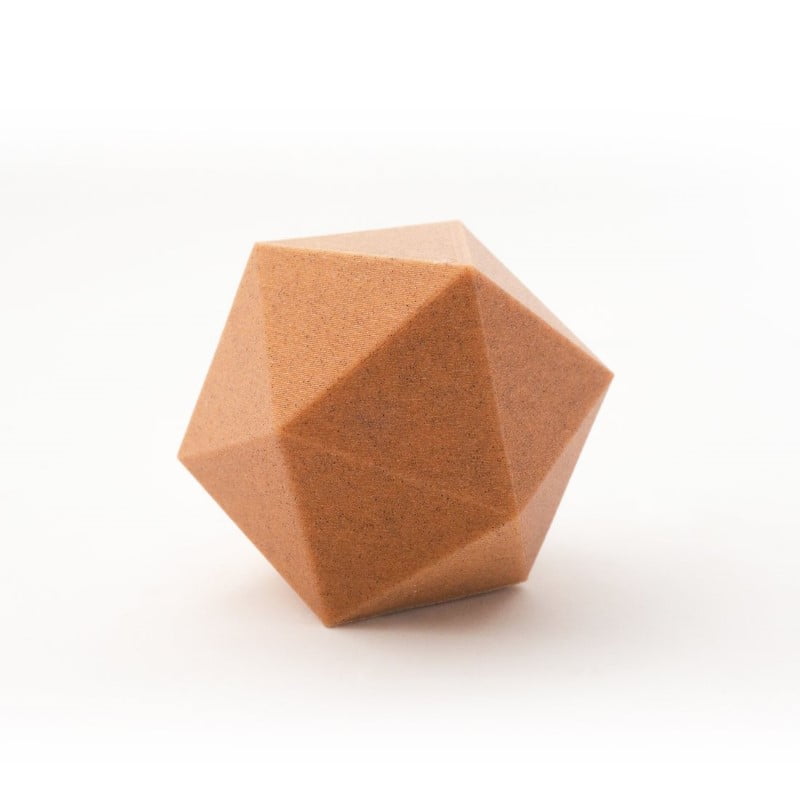
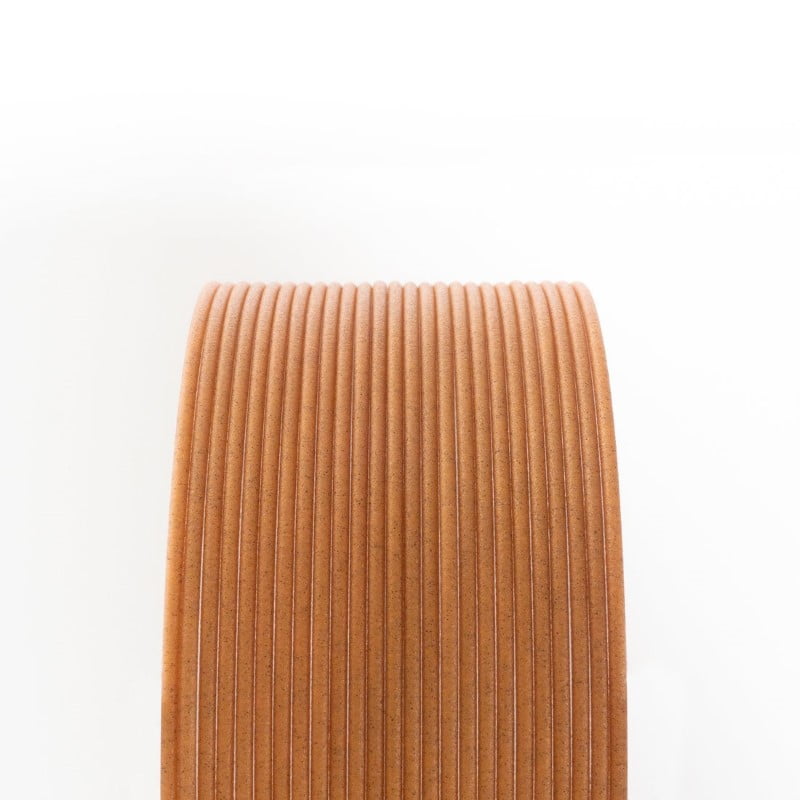
An extension of our Matte Fiber line, these rich colors are enhanced with small black flecks to create a wood-like appearance. Ranging from a beautiful soft yellow to deep, dark walnut, we’ve covered the spectrum and are excited to share their beauty with all of you!






L to R: Walnut, Chestnut, Mahogany, Honey, Daffodil, Olive
These materials are based in Matte Fiber, but with fine gold pearl and black flecks, bringing warmth, radiance, and texture with just the right tones and sheen you’d expect for a premium wood-like finish.

All example parts were printed as follows for a balance of quality, speed, and reliability:
Machine(s): Prusa MK2/3, Creality Ender 3
Nozzle: 0.4 mm standard brass w/ sock
Nozzle Temp: 205C Bed Temp: 60C Bed Type: Glass, PEI, BuildTak, or other
Bed Prep: Clean w/ water or alcohol; Magigoo for additional adhesion + easy release when cool
Outlines: 3 Top/Bot layers: 6 Infill type: Lines Infill: 25%
Overlaps: 0 Min layer time: 0 Min Speed: 0 Fill gaps: no Expansion: 0
| Layer height | Ext width | Speed | Fan | |
| 1st Layer | 0.20mm | 0.50mm | 20mm/s | 0% |
| Rest of print | 0.15mm | 0.45mm | 30mm/s | 100% |
Matte Fiber can create beautiful, rigid parts that don’t even look 3D printed. Like wood, Matte Fiber does not bend much before breaking.
Please don’t use excessive force when loading and printing.
Matte Fiber also absorbs moisture like wood, and should be printed at the lowest possible temperature to minimize stringing, over-extrusion, and jamming.

We've created this page to bring you a premium PLA and HTPLA printing experience that rivals our premium material. Follow below to improve your 3D printing experience. In other words, here's your shortcut to awesomeness with pasta. If at the end of this document you have questions or need assistance, please contact us at [email protected].
Loose coils can be very tricky to manage. Going cowboy on your spool handling can quickly end up in a frustrating, tangled mess. Keep your loose coils wrangled with a spool holder like masterspool for a more trouble-free experience. Find out more about loose coil handling in Keith's blog post.
And for spooled filament, never let go of the loose end. When not in the printer extruder, tuck it away in the cardboard spool's corrugation! Also, avoid sharp bends and excessive force when loading filament into your printer.
At Proto-pasta, we make high quality filament. We aspire to make exceptional results easy, but a positive result is very much dependent on your hardware, set-up, adjustments, and process parameters. Matching hardware with process and material for a positive experience is not always straight-forward, but you can start by pairing the following settings with your printer for a good starting point, then tune or troubleshoot as required.
Volume flow rate together with temperature dictates how melted the material is. This is hardware & condition dependent based on hot end, nozzle & extruder type, material & manufacturer as well as layer fan type, position & settings. Extrusion width, layer thickness & speed changes affect volume flow which may change required/desired temperature.
Post your prints & tag us @Proto_pasta on Twitter and Instagram. Need more help? Consider typical pitfalls and fixes below.
We visited Joel and ended up with a helpful video on the subject:

Para uma correcta manutenção da sua impressora 3D, recomendamos sempre que trocar de material de filamento 3D, a efectuar uma purga com filamento especial de limpeza.
Desta forma garante que não ficam vestígios de material nas paredes do nozzle, evitando o acumular de crosta que é criado sempre que efectua trocas de material.
Com este produto evita problema como "clogs" e "jams" e fará com que o seu nozzle mantenha-se sempre limpo, durando muito mais tempo.
Poderá encontrar a partir de 1.49€ no seguinte LINK

Para obter maior aderência à superfície da sua impressora 3D recomendamos a aplicar 3DLAC na base da plataforma.
Poderá encontrar no seguinte LINK

Este material é altamente higroscópico, absorvendo rapidamente a humidade do ar passados poucos minutos após aberto, impossibilitando desta forma a correcta impressão 3D do mesmo. O resultado das impressões 3D de materiais com humidade tendem a ser frágeis e de acabamento irregular ou em certos casos, torna-se simplesmente impossíveis de imprimir.
Deverá de usar soluções de caixas fechadas com dessecante como sílica ou caixas próprias secadoras de filamento.
Poderá encontrar no seguinte LINK
Download:
Technical and Safety Data Sheet
50g- Rolo
HTPLA Honey Wood ( Matte Fiber ) - Cor
1.75mm (+-0.05mm) - Espessura / Tolerância de diâmetro
Muito Fácil - Facilidade de Impressão

ProtoPasta é uma empresa situada nos Estados Unidos da América, de produção de filamentos para impressão 3D de alta qualidade.
Caracterizada pelos rolos feitos em cartão, esta marca é mundialmente famosa por ser especializada em materiais como PLA e ABS modificados com outros materiais, como o PLA Magnético; o PLA Condutivo; PLA de fibra de carbono; HTPLA de cobre, latão ou bronze; ou o ABS-PC.


Protopasta Polycarbonate-ABS Alloy is an incredibly tough material designed for strong, resilient parts.
Properties are excellent and greatly improved over standard ABS.

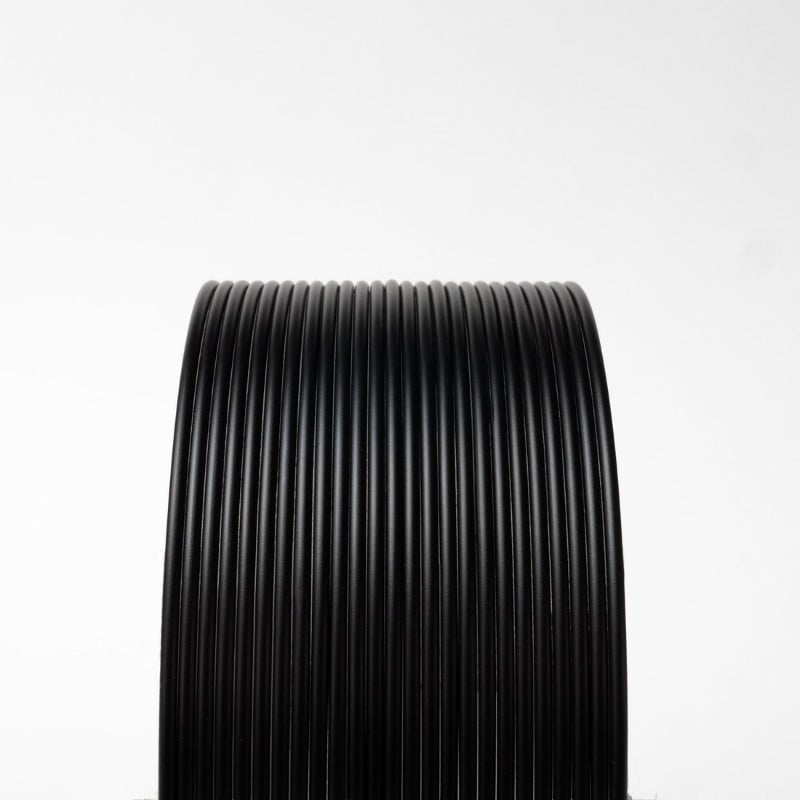
Processing is more challenging. For best results, a heated bed is required to control warpage and improve layer adhesion. Cross-sectional area should be minimized.
PC-ABS is moisture sensitive.
Even when stored in a bag with desiccant, drying in an oven for ~ 1hr at 85C-95C may be required for bubble free high strength prints.
In our experience, good results are achieved when printing small parts at 270-290C on a heated bed at 110C up to 140C.
For larger prints with good layer adhesion and minimal distortion, an enclosure is ideal.

A fan favorite, our Polycarbonate-ABS (PC-ABS) Alloy is an incredibly tough material designed for strong, resilient parts.
This unique material provides vast improvements (over standard ABS) in heat deflection, impact resistance, rigidity, and flexibility.
What are the hardware requirements?
PC-ABS is a high performance material that produces excellent prints, but it is a finicky material prone to warping during the printing process if temperatures are not consistent.
A heated bed (120° is optimal) and 260°+ hot-end are required, an enclosure to is highly recommended.
How should I store it?
Our PC-ABS filament is very moisture sensitive and should be kept bagged with desiccant. Drying in an oven at 85-95° C for an hour may be required for good printing.
The filament is very tough and easy to feed into the printer.
Print Settings
You will have to play around with printer settings to determine what works best on your machine, but start with your heated bed at 120° C and hot end at 260° C and go from there.
Layer adhesion can be an issue if the part is large or the temperature is too low.
We have had good success printing parts ~60mm long at 260°-280° C using a .5mm nozzle and direct-drive spring loaded pinch-roll style extrusion head.
A heated bed set to 120 C will help warpage and layer adhesion on larger/thicker parts.
Density:
1.13 g/cm3 (1130 kg/m3)
Parameters:
Bed Temp (REQUIRED): 120°+ C
Hot End Temp: 260 – 280° C
Full enclosure recommended

Para uma correcta manutenção da sua impressora 3D, recomendamos sempre que trocar de material de filamento 3D, a efectuar uma purga com filamento especial de limpeza.
Desta forma garante que não ficam vestígios de material nas paredes do nozzle, evitando o acumular de crosta que é criado sempre que efectua trocas de material.
Com este produto evita problema como "clogs" e "jams" e fará com que o seu nozzle mantenha-se sempre limpo, durando muito mais tempo.
Poderá encontrar a partir de 1.49€ no seguinte LINK

Este material é considerado de difícil aderência à superfície da plataforma de impressão 3D de vidro ou PEI. Para evitar problemas de warpping e de aderência das peças, recomendamos a aplicar potenciador de aderência especial para PC Policarbonato.
Poderá encontrar no seguinte LINK

Este material é altamente higroscópico, absorvendo rapidamente a humidade do ar passados poucos minutos após aberto, impossibilitando desta forma a correcta impressão 3D do mesmo. O resultado das impressões 3D de materiais com humidade tendem a ser frágeis e de acabamento irregular ou em certos casos, torna-se simplesmente impossíveis de imprimir.
Deverá de usar soluções de caixas fechadas com dessecante como sílica ou caixas próprias secadoras de filamento.
Poderá encontrar no seguinte LINK
Download:
Technical and Safety Data Sheet
50g- Rolo
High Temperature Polycarbonate-ABS Alloy - Cor
1.75mm (+-0.05mm) - Espessura / Tolerância de diâmetro
Difícil - Facilidade de Impressão